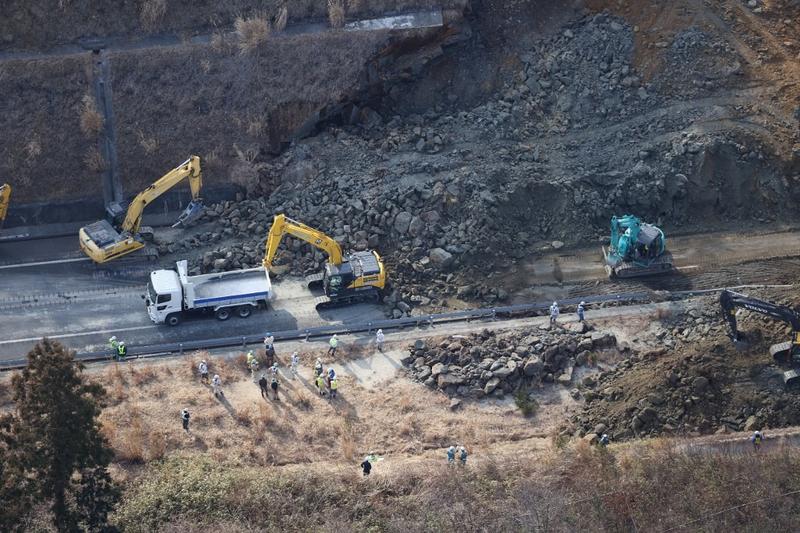 This aerial picture taken from a Jiji Press chartered aircraft shows the landslide site on the Joban Expressway in Soma, Fukushima prefecture on February 14, 2021 after a 7.3-magnitude earthquake struck off Japan's east coast late on February 13. (STR / JIJI PRESS / AFP)
This aerial picture taken from a Jiji Press chartered aircraft shows the landslide site on the Joban Expressway in Soma, Fukushima prefecture on February 14, 2021 after a 7.3-magnitude earthquake struck off Japan's east coast late on February 13. (STR / JIJI PRESS / AFP)
Japan began assessing damage and restoring power after a magnitude-7.3 earthquake struck off Fukushima late Saturday, leaving about 150 people injured and temporarily cutting power to almost a million households.
No deaths were reported, according to public broadcaster NHK, and Prime Minister Yoshihide Suga said at a press conference on Sunday that no incidents were reported from reactors. Six coal- and gas-fired power units, with a combined capacity of about 3.6 gigawatts, are offline due to the quake without any timeline for restart, according to the Japan Electric Power Exchange.
The powerful tremor, which was felt in Tokyo, occurred just one month before the 10-year anniversary of the 2011 earthquake and tsunami that led to a meltdown at three reactors of the Fukushima Dai-ichi nuclear plant and left about 19,000 people dead or missing. The latest tremor was an aftershock of the 2011 quake, according to Japan’s national meteorologist.
The latest tremor was an aftershock of the 2011 quake, according to Japan’s national meteorologist
Major industries appeared to escape significant damage. Although about 14 percent of the country’s total crude oil refining capacity went offline because of the quake or related power outages, Toyota Motor Corp and Nissan Motor Co said their factories were not affected and scheduled to operate on Monday.
ALSO READ: Japan quake brings back memories of 2011 tsunami
Tokyo Electric Power Co said there was a minor overflow of water from the pool that stores used atomic fuel at the Fukushima nuclear plants, but no uncontrolled radiation was detected, NHK reported. Suga said Monday 12 people sustained serious injuries from the quake and 141 were slightly injured.
Mitsui Chemicals Inc. said its Ichihara plant, which includes a naphtha cracker, in Chiba was shut due to a power outage. It would take about 10 days to restart the plant.
East Japan Railway Co said part of its high-speed bullet and local train services will remain suspended until Monday due to damages to electrical lines. The Tohoku Shinkansen bullet train line would need 10 days to resume its full service, according to NHK.
East Nippon Expressway Co cleared one lane for emergency cars after a landslide. They are continuing to do clearing work, and expect regular travel to resume the middle of this week.
Orocobre Ltd said an initial inspection of the Naraha Lithium Hydroxide Plant with the construction contractor Veolia Jenets found minor damage to the site office but did not find any visible defects to plant equipment.
ALSO READ: Quake shakes NW Japan, causes 21 injuries and minor damage
The Saturday-night tremor hit the Tohoku region, 220 kilometers (135 miles) north of Tokyo, the Japan Meteorological Agency said. More than 830,000 households in the Tohoku and Kanto regions experienced power outages, but supply resumed in most areas by Sunday morning.
Day-ahead wholesale electricity prices for Tokyo surged nearly 3-fold to about 14 yen per kilowatt hour on Sunday due to the numerous outages at regional power plants. Rates slipped 46 percent on Monday as traders expect more plants to resume operations, avoiding a supply crunch.
Nationwide average spot power prices slipped 9.5 percent to 7.35 yen per kilowatt hour on Monday.
READ MORE: Reports: Japan to release Fukushima water into sea


